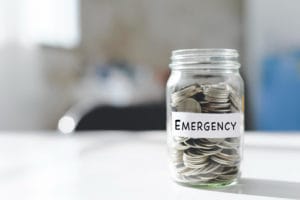
How to Start Building an Emergency Fund
The best way to handle unexpected financial challenges is to be prepared, though planning for the unknown can feel daunting. A good way to start is by building an emergency fund. This is a dedicated savings account that acts as a safety net when sudden expenses come up, such as car repairs, medical bills, or an unexpected move. This financial cushion can help you manage surprises without relying on debt. Creating an emergency fund is vital for financial stability and helps reduce financial stress, especially in today’s economic climate. Many people don’t know where to start, and it can be hard to figure out how much to save, how to build your fund, where to store it, and when to use it. But once you get started, this fund will provide peace of mind by covering unexpected costs, helping you avoid high-interest debt during crises.
Here’s a guide to help you get started, focusing on setting realistic savings goals, staying consistent, budgeting wisely, and only considering payday loans as a last resort.
Setting a Savings Goal
The first step in building an emergency fund is to set a clear savings goal. A common recommendation is to aim to save enough to cover three to six months’ worth of essential expenses, providing a substantial safety net for most unexpected situations. However, if you feel you would benefit from saving more, you can never be too prepared. That said, building an emergency fund takes time, and accumulating three to six months’ worth of expenses doesn’t happen overnight. It’s essential to save what you can without overstretching yourself or incurring debt to reach this goal.
Begin by listing your necessary monthly expenses, such as rent or mortgage, utilities, groceries, insurance, and debt payments. Calculating this total gives you a specific target, which makes the process feel more achievable. Beyond the financial benefits, having a savings goal also keeps you motivated. A clear target helps you see your progress over time, reinforcing the importance of the fund and giving you a sense of accomplishment as you get closer to your goal.
Being Consistent
Consistency is the foundation of successful saving. You don’t need to start with large amounts; small, regular contributions will grow into significant savings over time. Saving doesn’t follow a strict formula; the key is to progress at your own pace. While it’s helpful to be consistent, your savings amount doesn’t need to be the same every month. One month, you might be able to set aside more than expected, and the next, a bit less. The important thing is to save something each month, helping you build the habit and reducing the pressure of trying to set aside large sums upfront. Once you become comfortable with saving, try to increase your monthly contributions gradually, even if it’s by just a few dollars each time.
Creating a Budget
Budgeting is essential for building an emergency fund, as it helps identify areas where you can cut back and redirect funds into savings. Start by listing your income and categorizing all expenses into essentials (needs) and non-essentials (wants). This will help you notice your spending downfalls. Once you have a clear view of all your expenses, you may realize where you’re overspending and what expenses you can cut back on.
Reducing unnecessary spending can free up more funds for your emergency savings, allowing you to work toward your goal without sacrificing essentials. Budgeting tools or apps can help you track your spending, ensuring that you stick to your plan and steadily build your fund.
Planning for Unexpected Expenses
If an unexpected expense arises and your emergency fund is still growing, payday loan services like LoanPigUSA may provide a short-term solution in regulated states. These services offer quick access to funds, but it’s crucial to use them only with a clear repayment plan. As your emergency fund grows, your reliance on loans will decrease, but knowing you have a fallback during the fund-building phase can provide peace of mind.
Remember, building an emergency fund takes time, commitment, and patience. By setting clear goals, staying consistent, and creating a budget, you can create a financial cushion that offers security in times of need.
